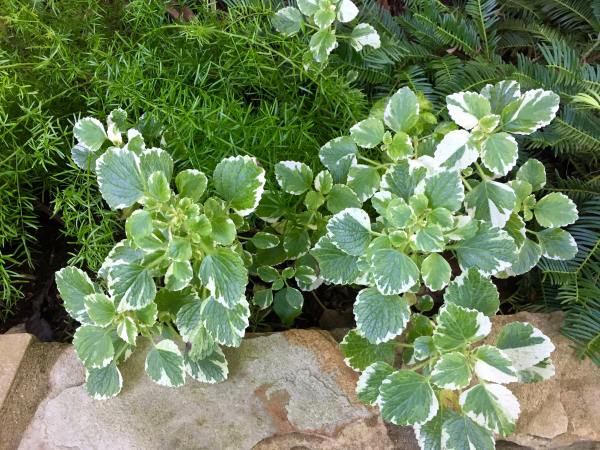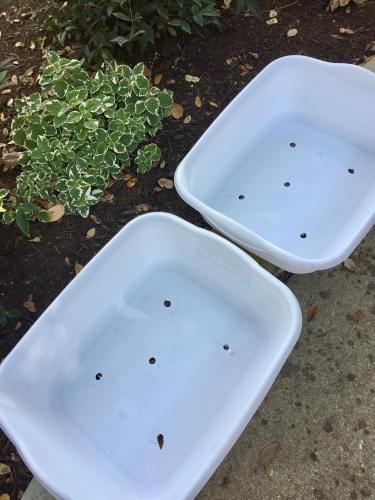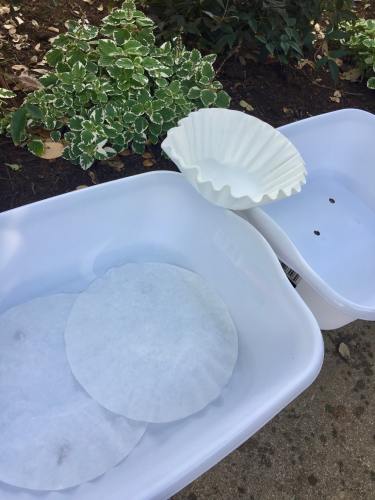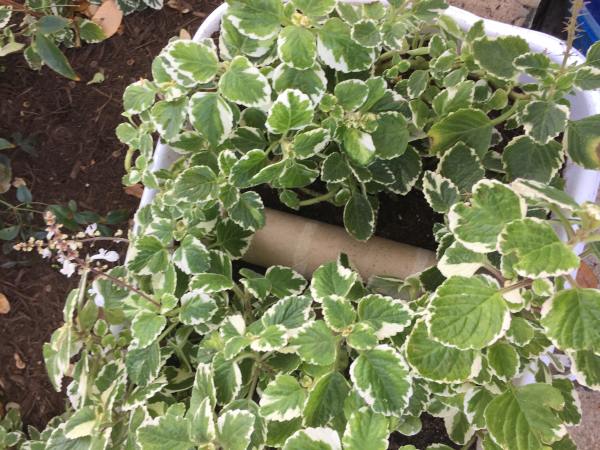Don’t you love the delicately textured, scalloped leaves of this variegated Swedish ivy? No surprise considering the oddities of botanical nomenclature, but it’s not an ivy and it’s not from Sweden, either. The botanical name is Plectranthus verticillatus, and it’s in the same And the scent is a heavenly citrus.
I’m always looking for beautiful variegated plants to add just one more pop of interest into my landscape beds. Swedish ivy is a tried and true favorite, along with Cuban oregano.
They’re slow and low growers in my garden, zone 8b, so I sprinkle them along bed borders for interest. They like a good bit of shade, and they have moderate water needs.
I planted some late last summer, then realized as we were facing the first cold snap that I didn’t want to lose them to the cold weather.
So, I bought two plastic dish pans from the a dollar store and drilled holes in the bottom. 
Well, to be honest, I didn’t actually drill the holes, Jeff did. Thank you, honey. You could also just poke the holes with a screwdriver or some other sharp object.
That’s actually what I was in the process of doing when Jeff saw me and said, very politely, “uhmmmm, why don’t you let me do that?” Ok, ok. So it wasn’t the most sophisticated approach, but I was getting the job done – really! (I could write a book on all of my “necessity is the mother of invention” approaches to problems.)
Then I used coffee filters to prevent soil from spilling out right away. Ultimately they would be draining into the floor of pea gravel from a shelf in the greenhouse. Once they started to re-root, it wasn’t an issue any more.

I dug up the plants from the garden when the temperature dipped below 50 at night, getting as many roots as possible.
Then I placed 2 clumps in each plastic container, allowing a little room for some winter growth.
To make it a little easier to separate them the next spring, I placed a paper towel tube between them. It didn’t separate them 100%, but it did help to contain them. It also made it a little bit easier to pull them apart without destroying the rootball or losing too much of the soil. They also produce small, white flowers which you can see on the photo below.
 They lived in the greenhouse through the winter where they thrived. What? No greenhouse you say? No problem. Around the world they are a popular houseplant, native to Australia and the Pacific islands. They look great trailing out of a hanging basket. So, plant them up in a pretty pot. They like bright indoor light, so find a special spot for them near a window.
They lived in the greenhouse through the winter where they thrived. What? No greenhouse you say? No problem. Around the world they are a popular houseplant, native to Australia and the Pacific islands. They look great trailing out of a hanging basket. So, plant them up in a pretty pot. They like bright indoor light, so find a special spot for them near a window.
If digging and replanting with the seasons isn’t your jam, just take a few cuttings and you can propagate them in a water glass like you did in high school.
I’ve watched them grow full and lush since spring, and will be pulling them up and overwintering them in the greenhouse again. I’ll probably bring a few into the house this year, too.
Now, don’t you want to grow this in your garden or in your house?

They’re great plants. Luckily, they’re fine in the ground year-round here. I call on my husband for assistance in “my” garden all too often as it is…